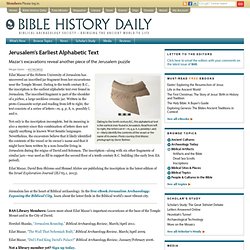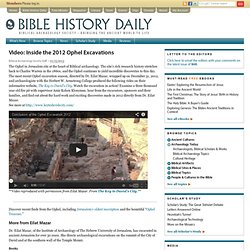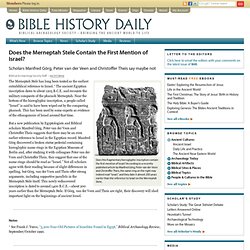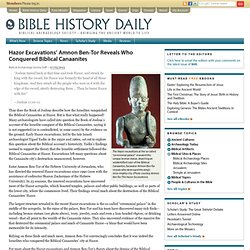

Biblical Archaeology Review Magazine - Biblical Archaeology Society. Biblical Archaeology Society. Dame Kathleen Kenyon, Digging Up the Holy Land - Biblical Archaeology Society. Dame Kathleen Kenyon, Digging Up the Holy Land by Miriam C.

Davis Walnut Creek, CA: Left Coast Press, 2008, 280 pp. $65 (hardcover), $24.95 (paperback) Reviewed by Magen Broshi Israel and the West Bank are, archaeologically speaking, the most researched piece of land in the world. The number of excavations and surveys carried out in this tiny area is by far greater than in much larger lands (the number is more than a thousand), and Kathleen Kenyon is surely one of the most important archaeologists to have dug here.
Kenyon was the daughter of Sir Frederic Kenyon, director of the British Museum and a celebrated classical and Biblical scholar. Next she went to Verulamium, in St. Most of her work, however, was carried out in Palestine, in three important sites: Samaria, Jericho and Jerusalem. In Samaria, Kenyon was part of the so-called Joint Expedition, made up of American, British and Israeli archaeologists, operating between 1931 and 1934. Did I Find King David’s Palace? – Biblical Archaeology Society. This article was originally published in the January/February 2006 issue of Biblical Archaeology Review.

In the September/October 2012 issue of BAR, Avraham Faust re-examines Eilat Mazar’s excavations in the article “Did Eilat Mazar Find David’s Palace?” Read about Faust’s article in Bible History Daily, or read the full article in the BAS Library or digital edition. Photo of area by Eilat Mazar; photo of statue by Erich Lessing/Art Resource, N.Y. In this composite electronic image, a statue of King David seems to hover above a building that may have been his palace. There can be little doubt that King David had a palace. I was struck by this idea while engaged in other research on the archaeology of Jerusalem. Eilat Mazar In 1995, not long before he passed away, I spoke with my grandfather, Professor Benjamin Mazar of Hebrew University, about my idea.
Bettmann/Corbis Mazar was not the first to make important discoveries in this part of Jerusalem. David Harris. Jerusalem’s Earliest Alphabetic Text: Mazar’s excavations reveal another piece of the Jerusalem puzzle – Biblical Archaeology Society. Dating to the tenth century B.C., this alphabetical text is the earliest ever found in Jerusalem.

Read from left to right, the letters on it—m, q, p, h, n, possibly l, and n—likely identify the contents of the vessel or the name of its owner. Photo courtesy Eilat Mazar; photograph by Ouria Tadmor. Eilat Mazar of the Hebrew University of Jerusalem has uncovered an inscribed jar fragment from her excavations near the Temple Mount. Ophel Excavation’s video highlights the 2012 season with Dr. Eilat Mazar – Biblical Archaeology Society.
The Ophel in Jerusalem sits at the heart of Biblical archaeology.

The site’s rich research history stretches back to Charles Warren in the 1860s, and the Ophel continues to yield incredible discoveries to this day. The most recent Ophel excavation season, directed by Dr. Eilat Mazar, wrapped up on December 31, 2012, and archaeologists with the Herbert W. Armstrong College produced the following video on their informative website, The Key to David’s City. Watch the excavation in action! **Video reproduced with permission from Eilat Mazar. Discover recent finds from the Ophel, including Jerusalem’s oldest inscription and the bountiful “Ophel Treasure.”
Dr. Books. Does the Merneptah Stele Contain the First Mention of Israel? - Biblical Archaeology Society. Biblical Archaeology Society Staff • 01/17/2012 Does this fragmentary hieroglyphic inscription contain the first mention of Israel?

According to a recently published article by Manfred Görg, Peter van der Veen and Christoffer Theis, the name-ring on the right may indeed read “Israel,” and they date it almost 200 years earlier than the reference to Israel on the Merneptah Stele. The Merneptah Stele has long been touted as the earliest extrabiblical reference to Israel.* The ancient Egyptian inscription dates to about 1205 B.C.E. and recounts the military conquests of the pharaoh Merneptah. Near the bottom of the hieroglyphic inscription, a people called “Israel” is said to have been wiped out by the conquering pharaoh. This has been used by some experts as evidence of the ethnogenesis of Israel around that time. Notes * See Frank J. Permalink: Hazor Excavations’ Amnon Ben-Tor Reveals Who Conquered Biblical Canaanites – Biblical Archaeology Society.
The Hazor excavations at the so-called “ceremonial palace” revealed this unique bronze statue, depicting an unidentified ruler of the Biblical Canaanites.

Excavator Amnon Ben-Tor reveals who destroyed this king’s once-mighty city. (Photo courtesy Amnon Ben-Tor/The Hazor Excavations) “Joshua turned back at that time and took Hazor, and struck its king with the sword, for Hazor was formerly the head of all those kingdoms. And they struck all the people who were in it with the edge of the sword, utterly destroying them … Then he burnt Hazor with fire” – Joshua 11:10–11.